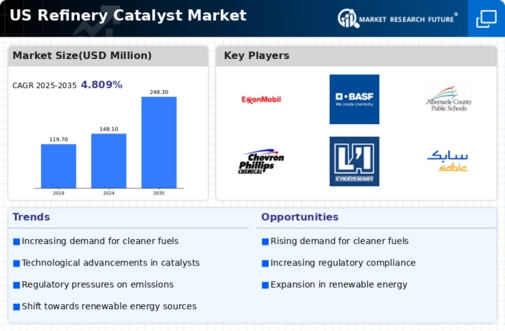The US Refinery Catalyst Market is a dynamic and competitive landscape characterized by various players striving to improve efficiency and reduce emissions in refining processes. As the demand for refined petroleum products continues to rise, driven by both domestic consumption and international demand, companies in this sector are innovating and optimizing their catalyst formulations. This market is influenced by regulatory frameworks aimed at enhancing environmental sustainability, driving refiners to adopt advanced catalytic solutions that can meet stringent guidelines while maximizing yield and productivity.
The competitive insights reveal a landscape where technological advancements, strategic partnerships, and intellectual property development play critical roles in shaping the direction of the market.Dow has established itself as a key player within the US Refinery Catalyst Market, leveraging its extensive portfolio of innovative technologies and strong R&D capabilities. The company possesses a robust market presence, focusing on refining catalysts that enhance operational efficiency and promote sustainable refining practices. Dow emphasizes its commitment to sustainability, which resonates well with regulatory trends and customer demands.
Its strength lies in its ability to deliver customized catalyst solutions that not only meet the specific needs of refineries but also improve productivity while reducing emissions. This customer-centric approach, combined with Dow's long-standing expertise in chemical manufacturing, positions the company favorably against competitors in the US refining sector.Haldor Topsoe, while smaller than some of its counterparts, maintains a prominent presence in the US Refinery Catalyst Market by concentrating on high-performance catalysts designed for hydrocracking and hydrotreating applications.
The company's portfolio reflects its commitment to innovation and sustainability, including key products that help refiners optimize their operations and achieve lower environmental footprints. Haldor Topsoe’s strengths include its highly specialized technical knowledge and strong relationships with clients, allowing for tailored solutions that enhance refining efficiency. The company has pursued strategic collaborations and partnerships in the US market, which boost its influence and ability to deliver cutting-edge technologies. Investments in R&D have led to the development of advanced catalyst formulations, strengthening its position in the market and aligning with trends in cleaner and more efficient refining processes.






















Leave a Comment